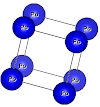There are two methods to do antiferromagnetic (AFM) calculation which are:
* Spin-polarized method: It's similar to the ferromagnetic calculation but it needs the use of an antiferromagnetic structure.
* Afm option method: It's different from the first and has its specific procedure.
NB: We will deal with all of them within this tutorial but the first one still the better way as it's mentionned at the following link:
https://wien2k-algerien1970.blogspot.com/2016/03/the-better-method-to-do.html
We will take two examples: one of the chromium Cr and the other of the nickel oxide NiO.
1. Example 01: Cr
Data :
* Spin-polarized method: It's similar to the ferromagnetic calculation but it needs the use of an antiferromagnetic structure.
* Afm option method: It's different from the first and has its specific procedure.
NB: We will deal with all of them within this tutorial but the first one still the better way as it's mentionned at the following link:
https://wien2k-algerien1970.blogspot.com/2016/03/the-better-method-to-do.html
We will take two examples: one of the chromium Cr and the other of the nickel oxide NiO.
1. Example 01: Cr
Data :
Lattice: bcc space group number : 229
a=b=c= 2.91 Ang
Cr (0.0.0)
a: The ferromagnetic calculation
We may create two structures to do ferromagnetic calculation (spin-polarized calculation):
- The first one is which is known to every one using the previous data.
- The second one is made by dissociating the bcc lattice of Cr in two sub-lattices of type P, every one containing only one atom Cr.
The data necessary to create this new structure will be deducted from the crystallographic symmetries and for our case will be as follows:
a=b=c= 2.91 Ang Lattice: P space group number : 221
Cr1 (0.0.0) Cr (1/2.1/2.1/2)
To do the ferromagnetic calculation we need only the make a spin-polarized calculation. To configure the magnetic orientation there are two choices:
- The first choice: The default one which all the spins are UP and the magnetic moment will be positive.
- The second choice: We do it manually which all the spins are DOWN and the magnetic moment will be negative with the same value.
NB: If you do the AFM calculation using the two structures, you will find a little difference in the total energy because of the difference in the energy's convergence with the kpoint parameter. It changes for different structures.
b : The antiferromagnetic calculation
To do the antiferromagnetic calculation we should only to use the second structure with the following data:
a=b=c= 2.91 Ang Lattice : P space group number : 221
We may get this structure automatically by using the SUPERCELL tool with 111 value and looking for a new space group after labelling the independent atoms by Cr1 and Cr2 and you will get the same space group number (221).
We can use both methods to do the AFM calculation.
1) The first one is similar to the ferromagnetic calculation except when arriving to the instgen option we make the atom Cr1 Up and Cr2 Dn and continue normally the calculation.
2) To do the AFM calculation using the afm option follow the procedure at the following link:
https://wien2k-algerien1970.blogspot.com/2016/02/how-to-do-antiferromagnetic-calculation.html
2. Example 02: NiO
a=b=c= 4.17 Ang Lattice : FCC Space group number: 225
Ni (0.0.0) O (0.0.1/2)
To do the AFM calculation we need to create the AFM structure of type II. There are 3 types of AFM order bu we have already known that the AFM order of the NiO is a type II.
NB: In the FCC lattices, there exists an effect called geometrical frustration which mean that we can't get a AFM order without getting a structural distortion. There are 3 types of distortion: along (001) plane (tetragonal distortion), along plane(011) (orthorhombic distortion) and along (111) plane (rhombohedral distortion which is in our case).
To create this AFM II structure we should do as in the f:ollowing link:
https://wien2k-algerien1970.blogspot.com/2016/03/wien-whats-crystal-structure-of-nacl-in.html
You will get the following structure:
NiO.struct
NiO
R LATTICE,NONEQUIV.ATOMS: 3
MODE OF CALC=RELA unit=bohr
5.605236 5.605236 27.459934 90.000000 90.000000 120.000000
ATOM -1: X=0.00000000 Y=0.00000000 Z=0.00000000
MULT= 1 ISPLIT= 4
Ni1 NPT= 781 R0=0.00005000 RMT= 2.0800 Z: 28.0
LOCAL ROT MATRIX: 1.0000000 0.0000000 0.0000000
0.0000000 1.0000000 0.0000000
0.0000000 0.0000000 1.0000000
ATOM -2: X=0.50000000 Y=0.50000000 Z=0.50000000
MULT= 1 ISPLIT= 4
Ni2 NPT= 781 R0=0.00005000 RMT= 2.0800 Z: 28.0
LOCAL ROT MATRIX: 1.0000000 0.0000000 0.0000000
0.0000000 1.0000000 0.0000000
0.0000000 0.0000000 1.0000000
ATOM -3: X=0.25000000 Y=0.25000000 Z=0.25000000
MULT= 2 ISPLIT= 4
-3: X=0.75000000 Y=0.75000000 Z=0.75000000
O NPT= 781 R0=0.00010000 RMT= 1.7900 Z: 8.0
LOCAL ROT MATRIX: 1.0000000 0.0000000 0.0000000
0.0000000 1.0000000 0.0000000
0.0000000 0.0000000 1.0000000
12 NUMBER OF SYMMETRY OPERATIONS
-1 0 0 0.00000000
0-1 0 0.00000000
0 0-1 0.00000000
1
-1 0 0 0.00000000
0 0-1 0.00000000
0-1 0 0.00000000
2
0-1 0 0.00000000
-1 0 0 0.00000000
0 0-1 0.00000000
3
0 0-1 0.00000000
-1 0 0 0.00000000
0-1 0 0.00000000
4
0-1 0 0.00000000
0 0-1 0.00000000
-1 0 0 0.00000000
5
0 0-1 0.00000000
0-1 0 0.00000000
-1 0 0 0.00000000
6
0 0 1 0.00000000
0 1 0 0.00000000
1 0 0 0.00000000
7
0 1 0 0.00000000
0 0 1 0.00000000
1 0 0 0.00000000
8
0 0 1 0.00000000
1 0 0 0.00000000
0 1 0 0.00000000
9
0 1 0 0.00000000
1 0 0 0.00000000
0 0 1 0.00000000
10
1 0 0 0.00000000
0 0 1 0.00000000
0 1 0 0.00000000
11
1 0 0 0.00000000
0 1 0 0.00000000
0 0 1 0.00000000
12
Conclusion
To prove that the material NiO is of type AFM II, we have to do 5 calculations: Non magnetic NM, Ferromagnetic FM and 3 AFM calculations I, II and III and we should fing that the AFM II state is the most stable when doing the Volume optimization. If not so, we have to use another method like DFT+U and modify the U parameter's value until getting this result.
GOOD LUCK
For more information check the following links:
https://wien2k-algerien1970.blogspot.com/2014/11/wien2k-faq-setup-of-antiferromagnetic.html
https://wien2k-algerien1970.blogspot.com/2016/03/the-better-method-to-do.html
https://wien2k-algerien1970.blogspot.com/2016/03/question-in-wien-mail-list-about.html
https://wien2k-algerien1970.blogspot.com/2016/03/from-wien-mailing-list-wien-afm-nio.html
http://wien2k-algerien1970.blogspot.com/2018/05/the-magnetic-structure-of-type-i-for.html











1 Comments
A-AFM, (c) C-AFM, and (d) G-AFM.
ReplyDelete